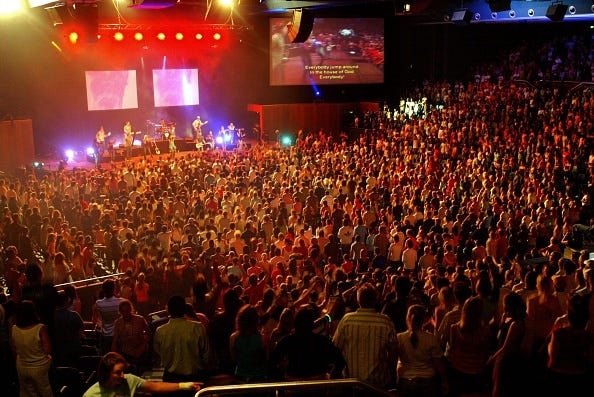The Anti-Relevancy Guide to Staying Relevant
Lessons from the megachurch on the power of staying in place and letting the culture come around to you
Twenty years ago, I wrote my thesis for a master's in religion on how consumerism had shaped the ethos of the megachurch and the consequences of that for the Christian gospel.
At the time, megachurches — large, contemporary, "seeker"-focused, typically non-denominational houses of worship — were really coming to the fore in places like Oklahoma, where I lived.
Emerging in earnest during the 1980s, megachurches were a response to the perception that Baby Boomers found traditional churches outdated and out of touch, considered their rituals stale and alienating, and were disenchanted with institutions generally.
Megachurches were premised on the idea that to reach the “unchurched” and bring them back into the fold, churches needed to provide the kind of experiences people were used to encountering in the marketplace: high-quality, accessible, non-intimidating, engaging, convenient, tailored to personal preferences, and above all — relevant.
To meet these expectations, churches saw that they would need to get much bigger and operate more like businesses. Larger size would allow for larger budgets and staff, which would enable the church to provide a smoother, more-polished, better-orchestrated experience to attendees.
A primary step in enhancing the church-going experience was stripping the church’s edifice and services of the traditional trappings Boomers and other spiritual seekers might potentially find off-putting and intimidating.
Rather than being housed in traditional-looking chapels, megachurches took up residence in strip malls and buildings that looked little different from big-box stores. Sanctuaries adorned with crosses and lined with pews were replaced with spaces that resembled a general-events auditorium, equipped with professional lighting and audio systems. Parking was always ample, and often serviced with roving golf carts to whisk attendees right from their vehicles to the church’s front door.
Rather than cultivating a clear demarcation between the sacred and profane, at a megachurch, the line between the spiritual and secular world was seamless. As Bill Hybels, founder of Willow Creek Community Church, said, he wanted people to feel like, “I was just at a corporate headquarters for IBM in Atlanta, Wednesday, and now I come to church here, and it’s basically the same.”
When Faith Community Church in California moved from a remodeled Dollar Saver grocery store to an aircraft manufacturing plant, the building was intentionally renovated to evoke the ambiance of a modern, upscale retail center. The pastor described the church’s reasoning this way:
“We did not want a traditional church atmosphere. What we were aiming for was the feeling of a mall. A place that is familiar, a real gregarious place. Malls are a neutral place and people feel comfortable in malls. So when people come into our church they will say, ‘Here’s a familiar place. I feel safe and secure here like in a mall.’”
The large size of megachurches gave visitors the space and anonymity to “window shop” the place without feeling pressured to make a commitment or consistently participate. As one man explained to the pastor of the small church he was leaving to join a big one: “My wife and I want to be in a church that doesn’t need us to be involved so much.”
Megachurches differed from traditional churches not only in their architecture and capacity, but also in the style of their services. Hymns were out; praise-and-worship pop music, performed by professional bands, was in. Pastors, dressed down in jeans, open-collar button-downs, and Nike hi-tops, offered "messages" instead of sermons, delivering them while roaming the stage with a headset microphone — TED-talk style — rather than from behind a pulpit. The content of these messages typically avoided heavy theology, focusing instead on practical, relatable self-help themes, buttressed by a few scriptural references.
The childcare at these churches was top-notch, and amenities for youth might include rock climbing walls and arcade games. Free snacks and beverages were typically provided for all.
Plenty of megachurches are still around and operating just as they did when I studied them in 2006. But, they have decreased in number and size over the last decade.
Of course, this is partly due to the fact that attendance has fallen for all churches, of all kinds, due to COVID and wider cultural factors. But beyond the numbers, there’s also just a feeling that the bloom is off the megachurch rose — they no longer seem as cool, as in. Having formed as a reaction to all that seemed outdated about churches, they now are beginning to feel outdated themselves — like a trend on the wane.
Some might say there was no harm in the rise and probable decline of the megachurch: it had a good run, tapped into what was most relevant in the early 2000s, saved a lot of souls, and now can just pivot into what will be most relevant to folks in the next few decades.
There were certainly some positives to the megachurch movement; while my thesis offered a critical take on the phenomenon, I’ve always recognized its upsides. Still, whatever short-term gains it produced may have come with long-term losses — and as we’ll see, “long-term” here carries a particular meaning.
There are some real dangers in chasing relevancy, whether you are a church that operates like a business or an actual business-business.
Let’s explore them.
Keep reading with a 7-day free trial
Subscribe to DYING BREED to keep reading this post and get 7 days of free access to the full post archives.


